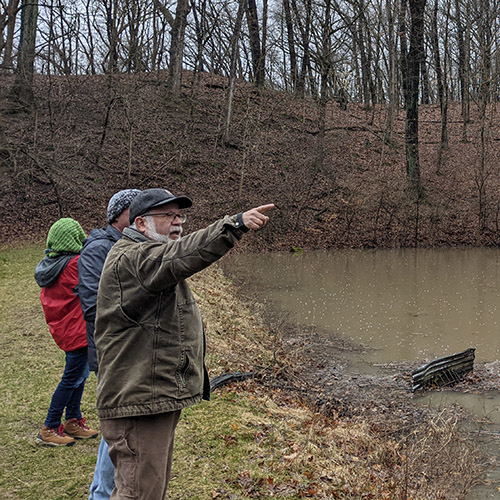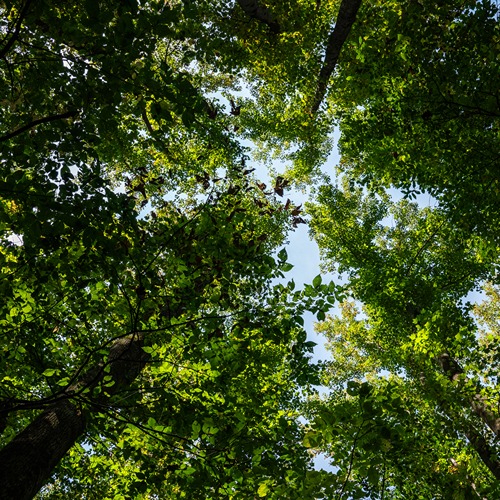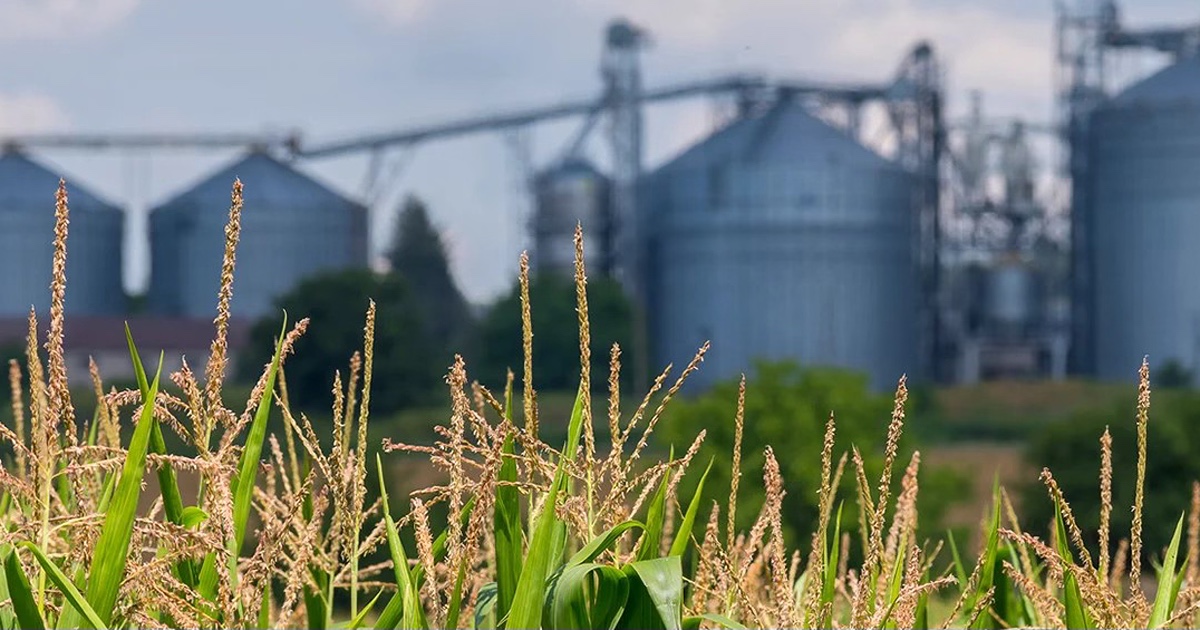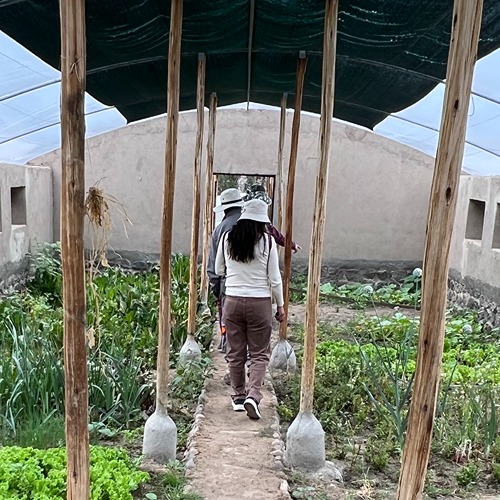Piecing together a forest puzzle
It made perfect sense for Douglass Jacobs, Fred M. van Eck Professor of Forest Biology and member of Purdue’s Institute for Digital Forestry, to spend his time as a 2024 U.S. Fulbright Scholar at the Swedish University of Agricultural Sciences (SLU) in Alnarp. More than 50% of Sweden is forested, so forestry is an important industry there. However, it also shares a land-use history with Indiana, including heavy deforestation and conversion to agriculture, and similar hardwood trees like oak, ash and maple.
“The environmental, economic and ecological benefits of hardwood forests are now well realized in both regions,” Jacobs says. “So there’s been a push in both to do more forest restoration to bring hardwood forests back, and a lot of that comes through tree planting.”
 (Photo: Jacobs with a birch tree in a hardwood regeneration study conducted with his SLU colleagues.)
(Photo: Jacobs with a birch tree in a hardwood regeneration study conducted with his SLU colleagues.)
What’s less clear is what the composition of that forest should be. Getting it right is a bit like putting a puzzle together when you don’t have a picture of the final image — so Jacobs and his colleagues are working to assemble it, bit by bit.
Hardwood plantations are valuable not only for wood products like high quality lumber for furniture, flooring, cabinetry and specialty crafts, but also for ecological benefits like conservation, wildlife habitat and carbon sequestration. But research on plantations has mostly been conducted with conifers like spruce and pine, so there are knowledge gaps in the optimal species mix for a productive hardwood plantation.
“There’s a lot of potential ecological benefits from diversifying the species mixes within a forest and potential commercial benefit as well,” Jacobs says, pointing out that greater tree species diversity allows for greater above- and below-ground diversity of flora and fauna. For example, planting one species that heavily shades the understory can prevent other species from growing, which in turn reduces the type of habitat available for wildlife.
Planting multiple species can also improve forest resilience, Jacobs says. “If we have a pest or pathogen move in and completely wipe out a species, if you’re planting a greater diversity of species then you have more opportunity to maintain forest cover.”
And that has economic benefits, allowing plantation owners to limit their risk but also to respond to a changing market. A hardwood stand may take 50 years to reach maturity, and the value of specific tree species can fluctuate depending on trends in consumer preferences. Having multiple species in a stand allows each one to be harvested and sold while their market value is relatively high.
Jacobs and his SLU colleagues have been collaborating for over 13 years, planting different trials and sharing data. In one experiment, they conducted trials planting oak and chestnut in the understory of white pine stands in Indiana. White pine was planted frequently by the Civilian Conservation Corps during the Great Depression, but with no softwood mills in the Midwest, there’s not a real market for it.
Jacobs and his colleagues planted oak and chestnut under pine with different overstory treatments, removing none of the overstory, half of it or clearcutting the pine before planting hardwoods. They also experimented with understory treatments like vegetation control and fertilization. Jacobs and his colleagues used part of their Fulbright time together to examine and write up the performance of the hardwood species under these different management conditions, showing that both are viable options for conversion of pine plantations. Oak performed better in clearcut stands, while chestnut performed better when sheltered under half the pine overstory. Weeding the understory increased the diameter of both tree species, depending on the overstory treatment.
Other experiments the group has conducted include planting three hardwoods — chestnut, cherry and oak — in single species or mixed plots. Initial analysis showed decreased productivity in the mixed plot, indicating this was not a complementary mix of hardwoods, so Jacobs has since established a new experiment with eight additional hardwood species planted in monocultures or mixtures.
“The goal of this work with mixed species it to try to identify compatible species mixes,” Jacobs says. “You have species that have different niches, for instance, in how they acquire resources from the soil or how they develop the structure of their canopy and leaves to capture sunlight or how they take up water. And ideally you would identify a mix of different forest tree species that have different adaptive niches that are complementary.”
Finding a combination of species that acquire resources differently, versus planting one species that competes for the same resources in the same way, means that in general, mixed species stands of trees are more productive overall than monocultural plantings.
Finding the right species mix isn’t the only challenge in the hardwood forest puzzle — so is controlling damage from browsing animals, namely deer. Fencing works well but is expensive, so Jacobs and his colleagues trialed alternatives. Since physical barriers tend to be more effective than repellents, they have tested piling brush, creating small “islands” for clumps of oak plantings in southern Sweden to keep deer out, alongside plantings with fencing or no protection at all. They also tested an additional treatment of adding a nitrogen-fixing shrub as a nurse tree to aid growth. Jacobs and his colleagues are analyzing the data from this five-year experiment in order to publish the results.
 Jacobs and his colleagues installed trials for the regeneration establishment of spruce.
Jacobs and his colleagues installed trials for the regeneration establishment of spruce.  They studied different methods of site preparation for new stands of spruce.
They studied different methods of site preparation for new stands of spruce. While in Sweden, Jacobs also used his experience working on seedling quality in nursery systems to examine the cold hardiness and optimal winter storage of birch seedlings, a species his Swedish counterparts plan to experiment with in mixed plantations. Toward the end of his stay, he co-led a Purdue summer study abroad course on international natural resources, hosting Purdue students at Alnarp and introducing them to students and colleagues at some of the other SLU campuses, including Uppsala and Skinnskatteberg.
Solving the puzzle of the optimal hardwood forest will take time, but Jacobs and his colleagues are working on it, piece by piece, with experiments ranging from Sweden to the stands in Martell Forest back on his home turf at Purdue. “These are 50- to 100-year rotation stands, and the beauty of the Martell site is that we established it 15 years ago,” Jacobs says. “We have a series of different projects out there and we’re really starting to get some good data at this point.”






